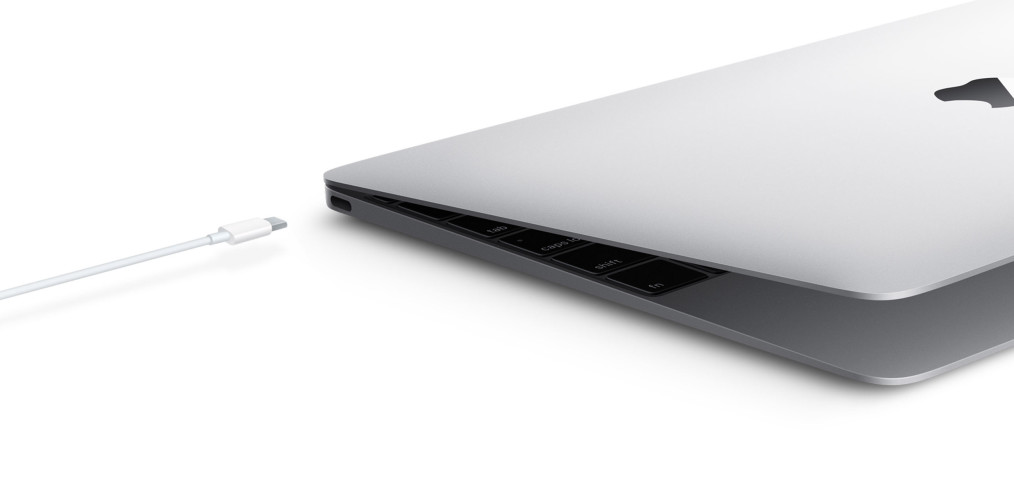
USB-C: One Cable to Rule Them All
Two weeks back, in the shadow of a revolutionary new smartwatch, Apple also unveiled a notebook computer like no other.
Christened the MacBook, a name shared with Apple laptops of iterations past, this new evolutionary device, while familiar and restrained, is, a big, bold step into the future of computing.
From any angle, it is undeniable that this new device is a MacBook – but behind new coats of gold, silver, or space gray paint, this one is impossibly smaller, thinner and lighter than we’ve ever seen. To achieve this, Apple had to perform engineering miracles – shrinking components down, and removing what it felt wouldn’t be necessary for future computer users.
For early adapters this transition will be painful, but one day it may all make sense. In the past, Apple, in a manner best attributable to “thinking ahead of its time”, also removed the optical drive (CD/DVD), Ethernet and FireWire from its laptops – each of these decisions were met with fierce criticism but made sense eventually.
This particular round of edits on the new MacBook however, is the most extreme ever – all ports were on the chopping block and everything had to go. Gone is the MagSafe port for connecting to a charger, gone are the usual pair of standard USB ports, there’s no SD card reader, not even the Apple’s own Thunderbolt port.
In place is one single port, for the a single cable to rule them all. The cable is called USB-C an evolution of the usual USB cable that can charge the device, transfer data impressive speeds, project audio and video signals, and more.
I don’t usually write about cables, but because USB-C could change computing as we know it, how can I not?
Why USB-C
Let me start by clarifying a possible misconception. USB-C was developed as an open standard, not proprietary to Apple – meaning more manufacturers will join the bandwagon soon.
Shortly after the launch of the new MacBook, Google announced the new ChromeBook Pixel with two USB-C ports. Soon USB-C will take over other devices including the micro-USB ports that are now the standard on smartphones and for good measure.
Fast
The cable is perhaps one of the most taken for granted pieces of technology – but there is much that goes on under the hood. Central to the essence of a cable is data transfer speed – as files get larger, the ability to transport get them from point A to point B – for example in the most basic sense from an external drive or memory card to your laptop is – at the shortest possible time is imperative.
The most widely USB 2.0 cables transfer data up to 0.5 Gbps, USB 3.0 can go up to 5 Gbps, the new USB Type C cables can transfer up to 10 Gbps – that’s 20x faster or theoretically 1 Full HD movie or 1000 songs in ten seconds.
Super Charged
One of the major benefits of USB-C is its ability to carry lots of power, up to 100 watts at 20 volts – this gives the computer enough juice with enough left over to power an external monitor or charge a smartphone.
For consumers this means faster charging, and potentially the end of bulky power adapters. Removing the need for internal power ports should also dramatically reduce the size of current laptops.
Because it’s USB – you will also soon be able to recharge your laptop with the same portable power bank you use for your smartphones – albeit slower. USB-C supports bi-directional charging meaning you could theoretically also take power from a tablet – instead of having the tablet take charge from your laptop.
Smaller & Reversible
Don’t you hate fumbling to plug in a USB cable in the dark? Current USB cables go in only one way, USB-C on the other hand is reversible, you can plug it in any which way – there is no upside down.
It’s also much smaller than existing USB cables – this is a good and bad thing, the new USB-C cable will take up less space – but as we’ve seen with Apple’s similar Lightning cables for iPhones and iPads – it also is more fragile.
Smart & Versatile
The cables of the future have brains – USB-C (also like Apple’s Lightning Cable) have embedded circuitry which allow for some sort of built-in intelligence. The cable knows what its being used for (are you charging or sending files) and adapts accordingly.
Because it is smart, it also can do more things at once – and this versatility really, is going to be the key to USB-C’s success. Of note is its ability transfer audio and video from your computer to say an external monitor, projector, or television (including via HDMI with the right adapter).
Growing Pains
Unfortunately with any major change – there will be growing pains. First to go will be all the USB cables you’ve collected over the years, and initially for old devices to work with new ones you will need expensive adapters. Apple for example is selling a $79 USB-C to HDMI, USB, VGA adapter.
There are already some USB-C peripherals in the market today – SanDisk for example makes a 32GB USB-C flash drive while and Lacie also ships an external drive with a USB-C connector. But expect this to be a slow and painful process.
Having said that, the potential is great, and the future looks bright.
There’s been so much fuss over the new MacBook’s lack of ports. But Apple, being Apple is forcing their vision of the future on consumers today – one where less is more rules.
It’s hard to imagine how wired technology will benefit a wireless future. But once this transition is over, we’ll actually need fewer ports and less cables, all because of this one cable that is smart enough to do it all at once.
“Sticker Mania” was first published in The Philippine Star on March 23, 2015 as part of my regular Gadget Week column. The Philippine Star Technology Section is printed every Monday, and is also available as a digital download from digitaledition.philstar.com.
